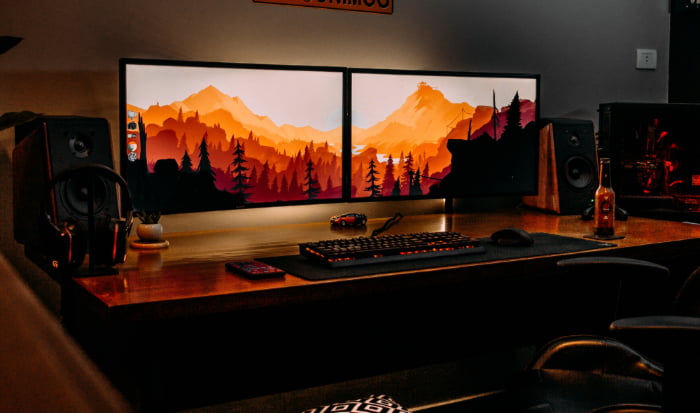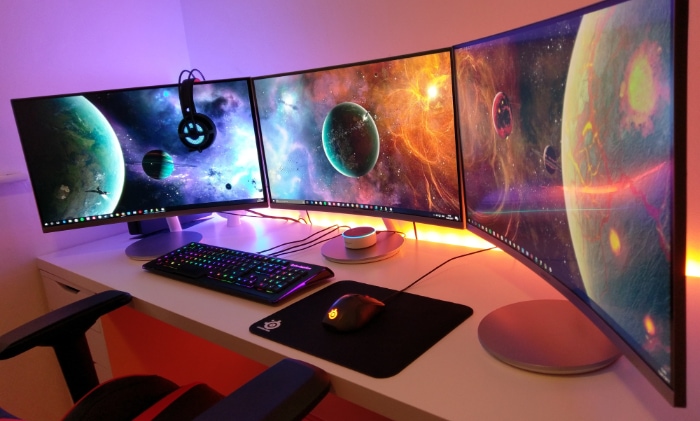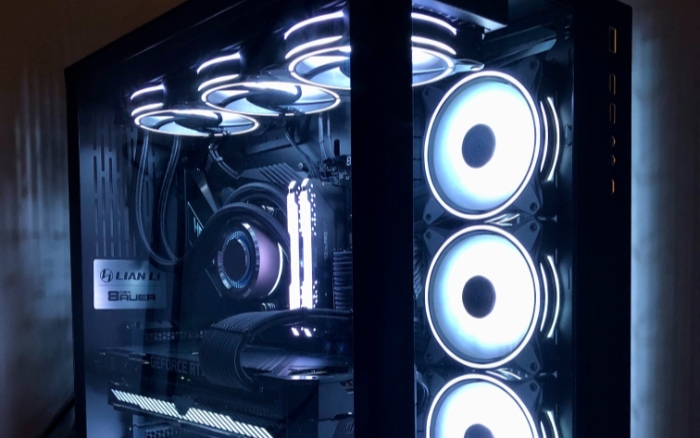75Hz vs. 144Hz: Deciding on Your Monitor Refresh Rate

Modern gaming monitors offer various refresh rates that significantly impact visual performance and gaming experience. Refresh rates, measured in Hertz (Hz), represent how many times your screen updates its image each second.
While 75Hz monitors provide smooth visuals above standard 60Hz displays, 144Hz monitors have gained popularity among gaming enthusiasts for their superior motion clarity and responsiveness.
Selecting between 75Hz and 144Hz monitors involves considering multiple factors beyond simple numbers. Professional gamers often prefer 144Hz displays for competitive advantages, while casual users might find 75Hz perfectly suitable for their needs.
Both options present distinct benefits and trade-offs in terms of performance, cost, and hardware requirements.
Understanding Refresh Rates
Refresh rate represents the number of times per second a monitor updates its display with new images, measured in Hertz (Hz). Think of it like a flipbook – the more pages you flip per second, the smoother the animation appears.
A 75Hz monitor refreshes 75 times per second, while a 144Hz monitor updates 144 times per second.
This frequent updating creates the illusion of smooth motion on your screen. The human eye can detect differences in motion well beyond 60 frames per second, which explains why higher refresh rates result in noticeably smoother visuals.
For example, moving your mouse cursor across a 144Hz display appears significantly more fluid compared to lower refresh rates.
Visual performance improves substantially with higher refresh rates. Text remains clearer while scrolling, objects maintain better definition during movement, and motion appears more natural.
These benefits become particularly noticeable during fast-paced activities like gaming or video editing.
Common Refresh Rates in Monitors
Modern monitors offer various refresh rate options, each serving different needs and preferences. The standard 60Hz refresh rate, found in most basic displays, provides acceptable performance for general computing tasks and office work.
Moving up to 75Hz brings a noticeable improvement in smoothness, making it an excellent middle-ground option.
The jump to 144Hz represents a significant upgrade in visual fluidity. This higher refresh rate shows its value in scenarios involving rapid movement or quick reactions.
Fast-paced games become more responsive, and even simple tasks like dragging windows across the screen feel more immediate and natural.
The difference between these refresh rates becomes most apparent during side-by-side comparisons. While 75Hz offers a 25% increase in refresh rate over 60Hz, 144Hz provides an even more substantial improvement – nearly 2.4 times more frequent updates than a standard 60Hz display.
This dramatic increase results in remarkably smooth motion and reduced motion blur during fast-moving scenes.
Performance Differences

The gap between 75Hz and 144Hz monitors becomes apparent in real-world usage, particularly in how they handle motion and user input. These differences affect both visual quality and overall responsiveness, creating distinct experiences for users.
Smoothness and Motion Clarity
Motion clarity represents how well a display maintains image sharpness during movement. A 144Hz monitor significantly reduces motion blur compared to a 75Hz display, resulting in clearer visuals during fast-paced scenes.
This improvement stems from the shorter time gap between frame updates – approximately 6.94 milliseconds for 144Hz versus 13.33 milliseconds for 75Hz.
The enhanced motion clarity becomes most noticeable in specific scenarios. During fast camera pans in first-person shooters, enemies remain more clearly visible on a 144Hz display.
Racing games demonstrate this advantage through sharper track details and clearer environmental textures while driving at high speeds. Even everyday tasks benefit from this improvement – scrolling through web pages appears smoother, and dragging windows across the desktop feels more natural.
Images maintain better definition during movement on higher refresh rate displays. Text remains readable while scrolling, and moving objects hold their shape more effectively.
This reduction in motion blur helps reduce eye strain during extended viewing sessions and provides a more comfortable viewing experience overall.
Input Lag and Responsiveness
Input lag refers to the delay between performing an action and seeing its results on screen. Higher refresh rates directly influence this aspect of performance by processing and displaying inputs more frequently.
A 144Hz monitor updates twice as often as a 75Hz display, creating a more immediate connection between user actions and on-screen responses.
This improved responsiveness particularly benefits competitive gaming scenarios. In fighting games, players can react more precisely to opponent movements.
First-person shooter players experience better target tracking and more accurate aim due to smoother mouse movement representation. These advantages might seem subtle, but they add up to create a notably more responsive gaming experience.
The reduced input lag also enhances general computer use. Mouse movements feel more connected to cursor position, making precise tasks like photo editing or graphic design more intuitive.
The snappy response helps users maintain better control over their actions, resulting in a more satisfying interaction with their computer.
Professional gamers and enthusiasts often cite this responsiveness as a crucial factor in their performance. The combination of clearer motion and reduced input lag creates an environment where split-second decisions and reactions translate more effectively into on-screen actions.
This enhanced feedback loop helps players maintain better awareness and control in high-pressure gaming situations.
Gaming Experience

Different gaming styles and genres create varying demands for monitor performance. The choice between 75Hz and 144Hz displays can significantly impact gameplay quality and competitive advantage, depending on how you play and what games you enjoy.
Casual vs. Competitive Gaming
Casual gaming typically focuses on enjoyment and immersion rather than peak performance. For these players, a 75Hz monitor offers noticeable improvements over standard 60Hz displays without requiring substantial hardware investments.
Story-driven games, role-playing adventures, and strategy titles remain thoroughly enjoyable at 75Hz, as these genres generally don’t demand split-second reactions or precise tracking.
Moving to competitive gaming, 144Hz monitors provide substantial advantages. Professional players and serious enthusiasts benefit from the enhanced motion clarity and reduced input lag.
These improvements allow for better target tracking in shooters, more precise timing in fighting games, and overall smoother gameplay. The difference becomes particularly apparent in scenarios requiring quick reactions and accurate movements.
Competitive players often report feeling more confident in their abilities when using 144Hz displays. The smoother visual feedback helps them maintain better situational awareness and execute complex maneuvers more consistently.
This advantage becomes especially noticeable during tournament play or ranked matches where every millisecond counts.
Types of Games Benefiting from Higher Refresh Rates
First-person shooters (FPS) show the most dramatic improvements with higher refresh rates. Games like Counter-Strike, Valorant, and Apex Legends become more fluid and responsive at 144Hz.
Players can track moving targets more effectively and maintain better accuracy during fast-paced firefights. The reduced motion blur helps spot enemies quickly, while lower input lag ensures shots connect more reliably.
Racing games also demonstrate significant benefits from 144Hz displays. The enhanced motion clarity helps drivers better judge distances and racing lines, especially at high speeds.
Track details remain sharper during intense races, allowing for more precise vehicle control and better awareness of surrounding competitors.
Fighting games benefit from the reduced input lag of 144Hz monitors. Complex combo executions feel more natural, and players can react faster to opponent movements.
This responsiveness proves particularly valuable in games requiring frame-perfect timing for special moves or counter-attacks.
Real-time strategy (RTS) and multiplayer online battle arena (MOBA) games show moderate improvements at higher refresh rates. While not as crucial as in FPS games, the smoother scrolling and reduced motion blur help players maintain better awareness of battlefield conditions.
Unit movements appear more fluid, making it easier to track multiple elements during hectic battles.
Some genres, however, don’t gain significant advantages from higher refresh rates. Turn-based strategy games, visual novels, and puzzle games typically perform similarly on both 75Hz and 144Hz displays.
These genres prioritize thoughtful decision-making over quick reactions, making the refresh rate less influential on overall gameplay experience.
Cost Considerations

Selecting a monitor involves balancing performance benefits against budget constraints. The price difference between 75Hz and 144Hz monitors can be substantial, making it essential to evaluate the financial aspects alongside technical specifications.
Price Comparison
The cost gap between 75Hz and 144Hz monitors varies significantly based on size, panel type, and additional features. Typically, 75Hz monitors range from $150 to $300, offering good value for casual users and budget-conscious buyers.
These displays often provide excellent color accuracy and resolution options while maintaining reasonable prices.
144Hz monitors generally command higher prices, typically starting around $250 and extending beyond $500. This price increase reflects the advanced technology required to achieve higher refresh rates.
Premium 144Hz displays with additional features such as HDR support or higher resolutions can cost considerably more, sometimes reaching $700 or higher.
Value for Money
The value proposition of each refresh rate depends largely on intended use. For office work and casual gaming, 75Hz monitors deliver excellent value, providing smooth visuals at more accessible price points.
These displays offer noticeable improvements over 60Hz models without requiring significant financial investment.
Moving to 144Hz brings substantial performance improvements but at a higher cost. Competitive gamers often find this investment worthwhile due to the tangible advantages in gameplay.
Professional users who work with motion graphics or video editing might also justify the extra expense through improved workflow efficiency and reduced eye strain.
Panel technology also influences value considerations. Many 144Hz monitors use TN panels to keep costs lower, while some 75Hz displays feature IPS panels with better color reproduction.
This creates interesting trade-offs between refresh rate and image quality that buyers must carefully consider.
Long-term Investment
Monitor purchases often serve users for several years, making future compatibility an important consideration. 144Hz displays offer better potential for lasting relevance as games and applications continue to support higher frame rates.
This forward-looking aspect can help justify the higher initial cost.
Graphics card development also plays a role in long-term planning. As GPUs become more powerful and affordable, achieving frame rates above 75 FPS becomes easier in modern games.
A 144Hz monitor allows users to take full advantage of these hardware improvements without needing to upgrade their display again.
Additionally, resale value tends to favor higher refresh rate monitors. 144Hz displays typically retain their value better than 75Hz models, partially offsetting the higher initial investment.
This factor becomes particularly relevant for users who regularly upgrade their gaming setups or maintain current technology standards.
Hardware Compatibility

Maximizing the benefits of higher refresh rate monitors requires careful consideration of your computer’s hardware capabilities. The smooth gameplay experience promised by 144Hz displays depends heavily on your system’s ability to generate sufficient frame rates consistently.
System Requirements
Running games at 144 frames per second (FPS) demands significantly more processing power than achieving 75 FPS. Your computer needs robust specifications across several components to maintain these higher frame rates.
The CPU plays a crucial role in processing game logic and physics calculations, while RAM speed and capacity affect how quickly data can be accessed and processed.
Modern processors, such as AMD Ryzen 5/7 or Intel Core i5/i7 series, provide the computational power needed for high refresh rate gaming. A minimum of 16GB of RAM helps prevent bottlenecks during demanding gameplay scenarios.
Fast storage solutions, particularly SSDs, reduce loading times and help maintain consistent frame rates by quickly streaming game assets.
Display connection type also matters significantly. While DisplayPort 1.2 and newer HDMI versions support 144Hz operation, older HDMI ports might limit refresh rates to 75Hz or lower.
This makes checking your system’s display outputs essential before upgrading to a higher refresh rate monitor.
Graphics Card Capabilities
The graphics card bears the primary responsibility for generating high frame rates. Modern GPUs like the NVIDIA RTX 3060 or AMD RX 6600 series represent the minimum recommended hardware for consistent 144 FPS performance at 1080p resolution.
More demanding games or higher resolutions require even more powerful cards.
Beyond raw GPU power, the way games are configured plays a crucial role in achieving desired frame rates. Adjusting graphics settings allows users to find the sweet spot between visual quality and performance.
For instance, lowering shadow quality or reducing anti-aliasing can significantly boost frame rates, helping maintain smooth 144Hz performance even on mid-range hardware.
This balance between quality and performance becomes particularly apparent when comparing different types of games. Competitive titles such as CS:GO or Valorant are specifically optimized for high refresh rate gameplay, easily reaching 144 FPS on modest systems.
However, the same hardware might struggle to maintain even 75 FPS in graphically intensive titles like Cyberpunk 2077 or Microsoft Flight Simulator.
Potential Need for Upgrades
Moving from 75Hz to 144Hz gaming might necessitate several hardware upgrades. The graphics card typically requires the most attention, as older or entry-level GPUs struggle to generate sufficient frames for 144Hz displays.
Users with dated graphics cards should factor this upgrade into their monitor purchase decision.
CPU upgrades often accompany GPU improvements, especially for users with older processors. A powerful graphics card paired with an outdated CPU creates a performance bottleneck, preventing the system from reaching its full potential.
This bottleneck becomes particularly noticeable in CPU-intensive games like strategy titles or large-scale multiplayer games.
These more powerful components introduce additional considerations for system stability. A robust power supply becomes essential, as high-performance GPUs and CPUs draw significantly more electricity during intense gaming sessions.
Modern graphics cards often recommend 650W or higher power supplies to maintain stable operation.
Speaking of system connections, the link between your computer and monitor requires careful attention. Different cable standards support varying refresh rates and resolutions.
While DisplayPort 1.2 and HDMI 2.0 cables easily handle 144Hz at 1080p, older HDMI versions might limit your display to lower refresh rates. This makes cable compatibility an essential factor when planning your high refresh rate setup.
Conclusion
Choosing between 75Hz and 144Hz monitors ultimately comes down to personal needs, usage patterns, and available resources. Both refresh rates offer distinct advantages for different user groups and scenarios.
75Hz monitors provide a noticeable improvement over standard 60Hz displays, making them an excellent choice for casual gamers and general computer users. They deliver smoother motion without requiring substantial system upgrades or financial investment.
These displays work particularly well for story-driven games, creative applications, and everyday computing tasks.
144Hz monitors, while more demanding on both hardware and budget, deliver exceptional smoothness and responsiveness that benefit competitive gamers and professionals working with motion-heavy content.
The improved motion clarity and reduced input lag create a more immersive and responsive experience, especially in fast-paced games.
The decision to upgrade should consider several practical factors, including current hardware capabilities, potential upgrade costs, and primary use cases. For those who can support the hardware requirements and justify the expense, 144Hz monitors represent a significant upgrade in visual fluidity and responsiveness.
However, users with modest hardware or those primarily engaged in less demanding activities will find 75Hz monitors provide an excellent balance of performance and value.



